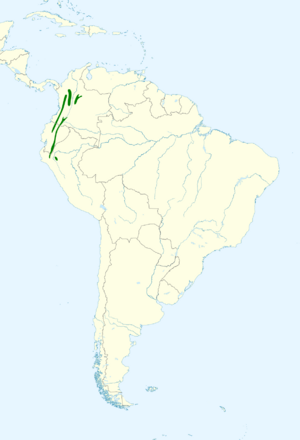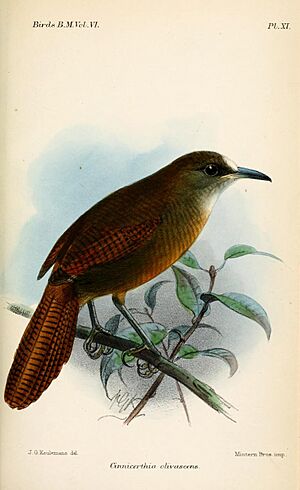Sepia-brown wren facts for kids
Quick facts for kids Sepia-brown wren |
|
|---|---|
 |
|
| Conservation status | |
| Scientific classification | |
| Genus: |
Cinnycerthia
|
| Species: |
olivascens
|
 |
|
| Synonyms | |
|
Cinnicerthia olivascens |
|
The sepia-brown wren is a small bird. It is also known as Sharpe's wren. This bird lives in South America. You can find it in countries like Colombia, Ecuador, and Peru. It belongs to the wren family, called Troglodytidae. Its scientific name is Cinnycerthia olivascens.
Contents
About the Sepia-Brown Wren
This bird was once thought to be a type of Peruvian wren. But scientists later found it was a different species. The Peruvian wren and the fulvous wren are like its close relatives. They are all part of a group called a superspecies.
The name "Sharpe's wren" honors a British zoologist. His name was Richard Bowdler Sharpe. This name helps avoid confusion with other wrens.
There are two main types, or subspecies, of the sepia-brown wren. One is called Cinnicerthia olivascens olivascens. The other is C. o. bogotensis.
What Does It Look Like?
The sepia-brown wren is about 16 centimeters (6.3 inches) long. Male birds weigh around 25.9 grams (0.9 ounces). Females are a bit lighter, at about 23 grams (0.8 ounces).
Both types of this wren are shades of brown. The most common type has a grayish-brown head. Its back and rump are reddish-brown. Its tail is chestnut-colored with dark bars. It might have some white on its face. Its chin and throat are light grayish-brown. This color gets darker on its belly.
The C. o. bogotensis type is much darker. It does not have any white on its face. Young wrens look like the adults. But their faces are more grayish.
Where Does It Live?
The sepia-brown wren lives in the Andes Mountains. You can find the main type in central and western Colombia. It also lives south through Ecuador. It reaches into the very north of Peru.
The C. o. bogotensis type lives only in western Colombia. It prefers wet, mossy forests. It also likes cloud forests. These are forests often covered in clouds. It usually lives at high elevations. This is between 1,500 and 3,100 meters (4,900 to 10,200 feet) high. Sometimes, it can be found lower, around 900 meters (3,000 feet).
How Does It Behave?
What It Eats
The sepia-brown wren looks for food on or near the ground. It likes thick plants. It often hunts in groups of up to 10 birds. Its diet includes small creatures without backbones. These are things like insects and their young. It also eats snails and earthworms.
Reproduction and Life Cycle
The sepia-brown wren is a cooperative breeder. This means more than just the parents help raise the young. A breeding pair works with up to five other wrens. They all build a roost nest together. They also sleep in this nest.
The breeding pair builds a separate nest for their eggs. This nest is a big, round ball. It has a tube-like entrance that points down. They make these nests from roots, moss, and bamboo leaves. They place them in small bushes or trees.
What It Sounds Like
The sepia-brown wren has a complex song. It changes a lot. It sounds like a series of musical phrases. The stress in the song changes. Its call is a soft, low "wurt". You can listen to its song and call online.
Is It Safe?
The IUCN (International Union for Conservation of Nature) checks on animals. They say the sepia-brown wren is of "Least Concern." This means it is not in immediate danger. It is quite common in good habitats. It also lives in several protected areas.
However, its population might be shrinking. This is because its home is being destroyed. Forests are being cut down. This breaks up the places where the wrens live.



